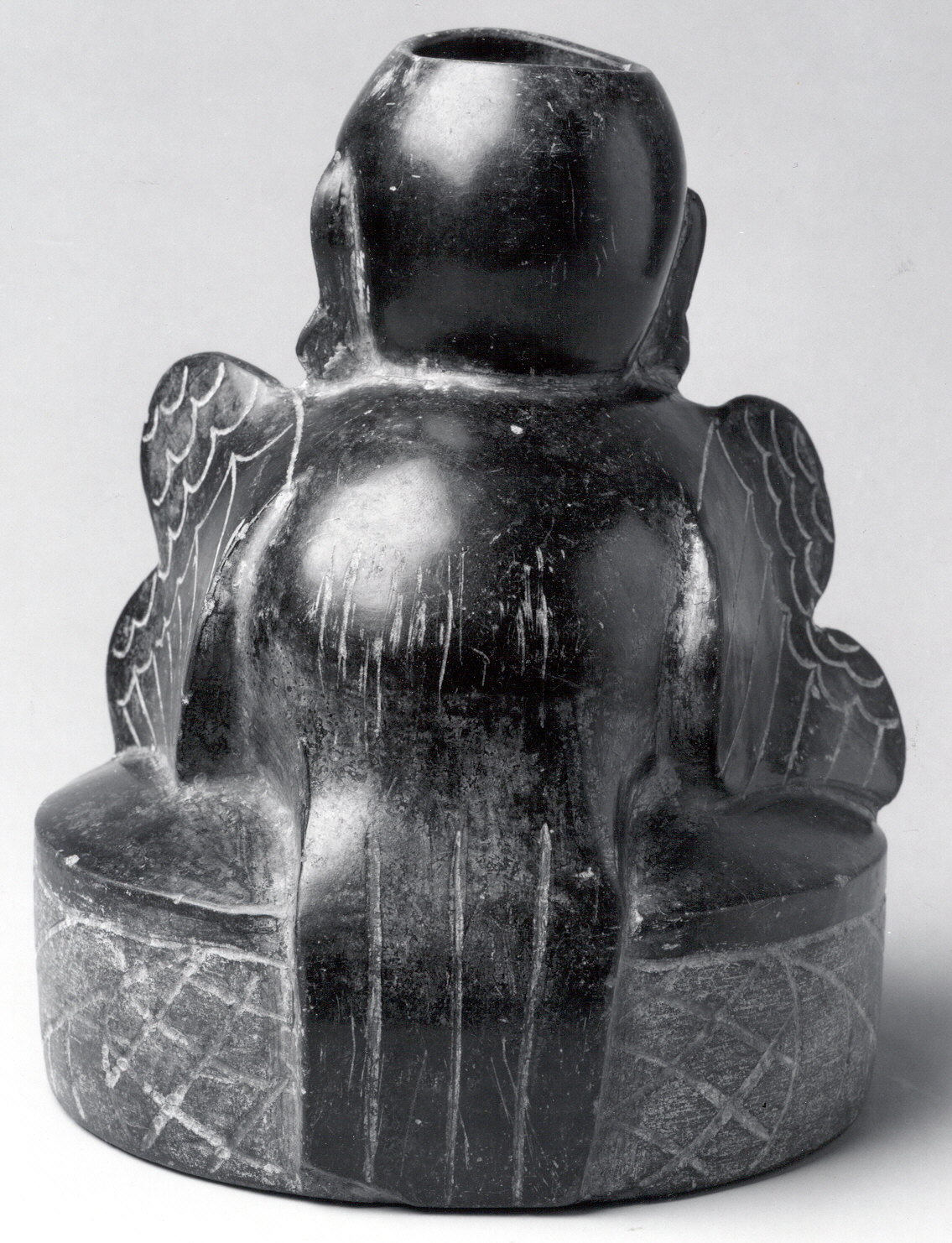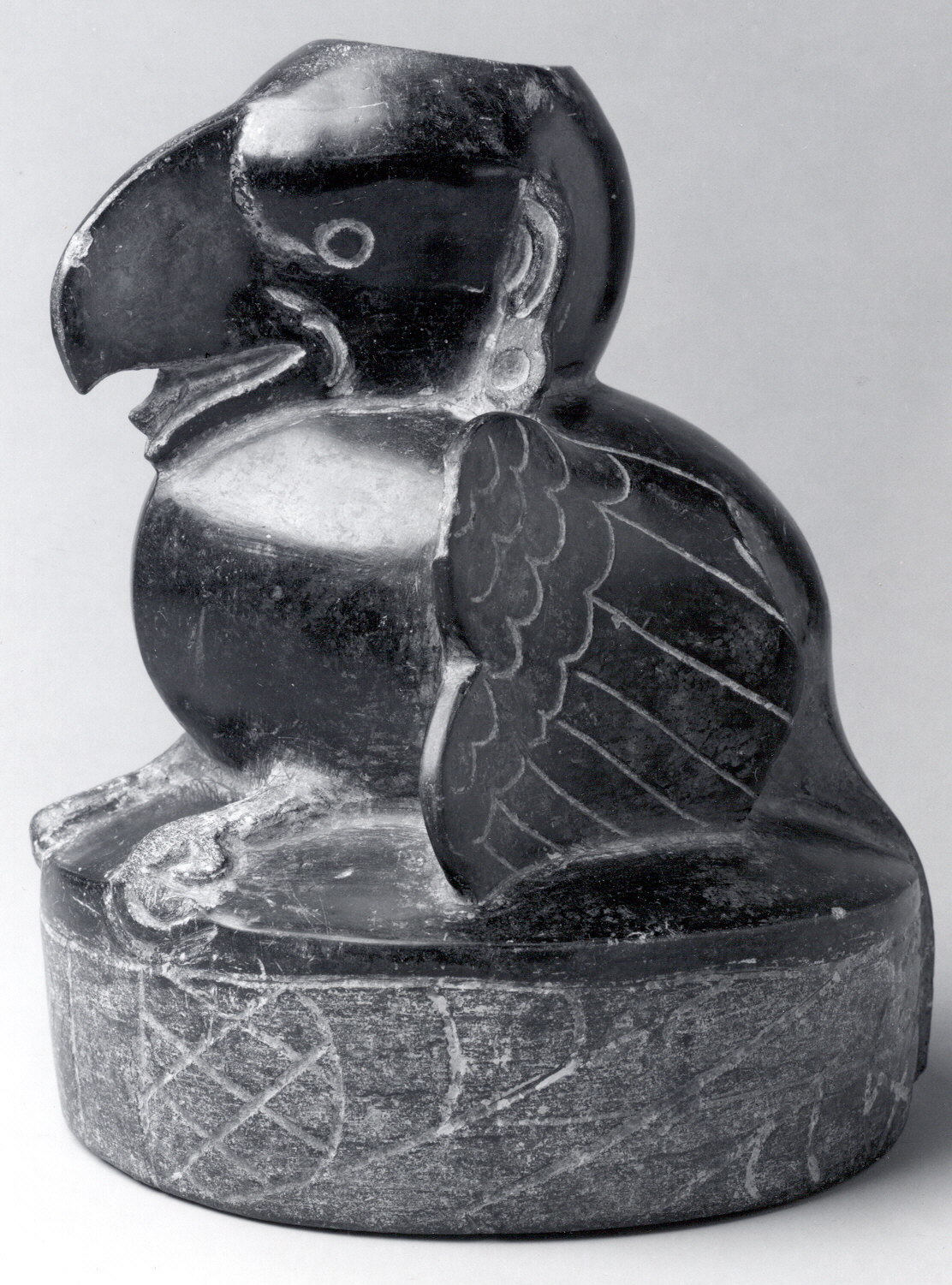Bird Vessel
Not on view
A potter created this complex ceramic vessel in the form of a juvenile bird of prey, perhaps a harpy eagle (Harpia harpyja). Built by hand, the chamber of the vessel includes a cylindrical base, perhaps symbolizing a nest, which is indicated by gouged and incised designs of linear fields and cross-hatched areas. The round nest is surmounted by a bird, seated with its claws spread to the sides rather than perched, with its wings splayed to either side. The long tail feathers of the bird spill over the side of the nest. The bird opens its hooked, narrow beak, exposing its tongue as if beseeching the viewer for food. The opening of the vessel is a circular hole in the top of the bird’s head.
Incised designs indicate the lines of the feathers on the wings and tail, the borders of the beak, and the circular eyes. This young raptor appears completely birdlike but has human ears extending from either side of the rounded head. The ears have contours and stretched lobes with depressions that indicate ear ornaments. Eagles and other birds of prey were powerful symbols in Olmec art, where they marked the realm of the sky and the precision of a hunter. The inclusion of humanlike ears here may indicate the intent of the artist to convey a moment of co-habitation or transformation from human to animal.
Further reading
Benson, Elizabeth P., and Beatriz de la Fuente, eds. Olmec Art of Ancient Mexico. Washington, D.C.: National Gallery of Art, 1996.
Berrin, Kathleen, and Virginia M. Fields, eds. Olmec: Colossal Masterworks of Ancient Mexico. San Francisco: Fine Arts Museums of San Francisco, 2010.
Cheetham, David, and Jeffrey P. Blomster, eds. The Early Olmec and Mesoamerica: The Material Record. Cambridge: Cambridge University Press, 2017.
Clark, John E., and Michael Blake. El origen de la civilización en Mesoamérica: Los Olmecas y Mokaya del Soconusco de Chiapas, Mexico. In El Preclásico o Formativo: Avances y perspectivas, Martha Carmona Macias, ed. Museo Nacional de Antropología, México City, 1989, pp. 385–403.
Clark, John E., and Michael Blake. The Power of Prestige: Competitive Generosity and the Emergence of Rank Societies in Lowland Mesoamerica. In Factional Competition and Political Development in the New World, Elizabeth M. Brumfiel and John W. Fox, eds., Cambridge: Cambridge University Press, 1994, pp: 17– 30.
Clark, John E., and Mary Pye, eds. 2000 Olmec Art and Archaeology: Social Complexity in the Formative Period. Washington, D.C.: National Gallery of Art.
Coe, Michael D. The Jaguar’s Children: Pre-Classic Central Mexico. New York: Museum of Primitive Art, 1965.
Coe, Michael D. The Olmec Style and Its Distributions. In Handbook of Middle American Indians, vol. 3 (Robert Wauchope, gen. ed.). Austin: University of Texas Press, 1965, pp. 739–775
Coe, Michael D. (ed.) The Olmec World: Ritual and Rulership. Princeton: The Art Museum, Princeton University, 1996.
Coe, Michael D., and Richard A. Diehl. In the Land of the Olmec: The Archaeology of San Lorenzo Tenochtitlán, 2 vols. Austin: University of Texas Press, 1980.
Covarrubias, Miguel. Origen y desarrollo del estilo artístico “Olmeca.” In Mayas y Olmecas: Segunda reunión de Mesa Redonda sobre problemas antropológicos de México y Centro América. Mexico City: Talleres, 1942, pp. 46-49.
Cyphers Guillén, Ann. From Stone to Symbols: Olmec Art in Social Context at San Lorenzo Tenochtitlán. In Social Patterns in Pre-Classic Mesoamerica (David C. Grove and Rosemary A. Joyce, eds.), Washington, D.C.: Dumbarton Oaks, 1999, pp. 155–181.
Drucker, Philip La Venta. Tabasco: A Study of Olmec Ceramics and Art. Smithsonian Institution, Bureau of American Ethnology, Bulletin 153. Washington, D.C.: Government Printing Office, 1952.
Drucker, Philip, Robert F. Heizer, and Robert J. Squier 1959 Excavations at La Venta, Tabasco, 1955. Smithsonian Institution, Bureau of American Ethnology, Bulletin 170. Washington, D.C.: Government Printing Office, 1959.
Easby, Elizabeth Kennedy, and John F. Scott Before Cortés: Sculpture of Middle America. New York: Metropolitan Museum of Art, 1970.
Feuchtwanger, Franz Ceramica olmeca. Mexico City: Editorial Patria, 1989.
Grove, David C. Olmec: What’s in a Name? In Regional Perspectives on the Olmec (Robert J. Sharer and David C. Grove, eds.): Cambridge: Cambridge University Press, 1989, pp. 8-14.
Joralemon, Peter David A Study of Olmec Iconography. Studies in Pre-Columbian Art and Archaeology 7. Washington, D.C.: Dumbarton Oaks, 1971.
Magaloni Kerpel, Diana, and Laura Filloy Nadal La Ofrende 4 de La Venta: un tesoro olmeca reunido en el Museo Nacional de Antropología. Mexico City: Instituto Nacional de Antropología e Historia, 2013.
Michelet, Dominique, Cora Falero Ruiz, and Steve Bourget Les Olmèques et les cultures du golfe du Mexique. Paris: Skira, 2020.
Pool, Christopher A. Olmec Archaeology and Early Mesoamerica. New York: Cambridge University Press, 2007.
Reilly, Frank Kent, III The Shaman in Transformation Pose: A Study of the Theme of Rulership in Olmec Art. Record of the Art Museum, Princeton University vol. 48 no. 2, 1989, pp. 4–21.
Taube, Karl A. Olmec Art at Dumbarton Oaks. Washington, D.C.: Dumbarton Oaks, 2004.
Due to rights restrictions, this image cannot be enlarged, viewed at full screen, or downloaded.
This artwork is meant to be viewed from right to left. Scroll left to view more.





